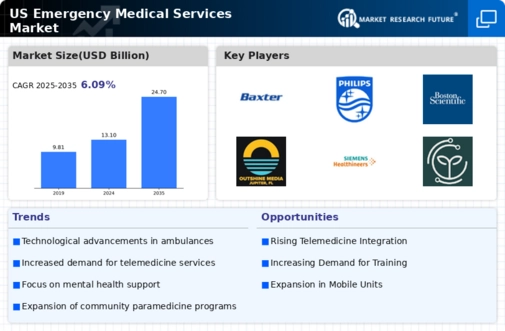The emergency medical services market in the US is characterized by a competitive landscape that is increasingly shaped by technological advancements and strategic partnerships. Key growth drivers include the rising demand for rapid response services, an aging population, and the integration of digital health solutions. Major players such as American Medical Response (US), Acadian Ambulance Service (US), and Falck USA (US) are actively positioning themselves through innovation and regional expansion. Their strategies not only enhance operational efficiency but also contribute to a more interconnected service delivery model, thereby intensifying competition within the market.
In terms of business tactics, companies are focusing on optimizing their supply chains and localizing service delivery to meet specific community needs. The market appears moderately fragmented, with a mix of large national providers and smaller regional players. This structure allows for a diverse range of services, although the influence of key players is significant in setting industry standards and practices.
In November 2025, American Medical Response (US) announced a partnership with a leading telehealth provider to enhance its emergency response capabilities. This strategic move is likely to improve patient outcomes by integrating telemedicine into pre-hospital care, thereby streamlining communication between paramedics and healthcare facilities. Such initiatives reflect a broader trend towards digital transformation in emergency services.
Similarly, in October 2025, Acadian Ambulance Service (US) expanded its operations into underserved rural areas by acquiring a local ambulance service. This acquisition not only broadens their service footprint but also aligns with their strategy to address healthcare disparities in rural communities. The move is indicative of a growing recognition of the need for accessible emergency services across diverse geographic locations.
Moreover, in September 2025, Falck USA (US) launched an innovative training program for its paramedics, focusing on advanced life support techniques and the use of AI in emergency response. This initiative underscores the importance of continuous professional development in maintaining high service standards and adapting to evolving medical technologies. The integration of AI is particularly noteworthy, as it may enhance decision-making processes in critical situations.
As of December 2025, the competitive trends in the emergency medical services market are increasingly defined by digitalization, sustainability, and the integration of AI technologies. Strategic alliances are becoming more prevalent, as companies recognize the value of collaboration in enhancing service delivery and operational efficiency. Looking ahead, competitive differentiation is likely to shift from price-based strategies to a focus on innovation, technology adoption, and the reliability of supply chains. This evolution suggests that companies that prioritize these aspects will be better positioned to thrive in an increasingly complex market.






















Leave a Comment